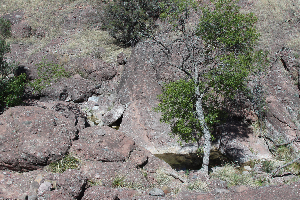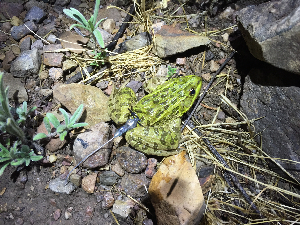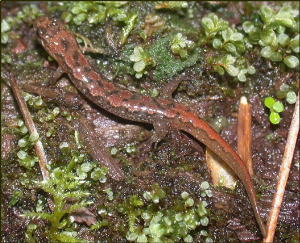Search ARMI Database
Search term(s)
Contribution Number
Search Results
9 record(s) found.
Data Release Data realease for manuscript: A statistical forecasting approach to metapopulation viability analysis
Authors: P E Howell; Blake R Hossack; Erin Muths; Brent H Sigafus; A Chenevert-Steffler; Richard Chandler
Date: 2020 | Outlet: Ecological Applications 2020: e02038
Data release and code for Ecological Applications paper: A statistical forecasting approach to metapopulation viability analysis
Papers & Reports Estimating metapopulation abundance to inform conservation of a threatened amphibian
Authors: P E Howell; Blake R Hossack; Erin Muths; Brent H Sigafus; Richard Chandler
Date: 2020 | Outlet: Herpetologica
In metapopulations, dispersal and population growth rates are influenced by patch quality, spatial structure, and local population density. Recently developed spatial metapopulation models allow inferences about distance effects on dispersal, but these models typically focus on patch occupancy rather than abundance of animals. Spatial occupancy models are useful for studying colonization-extinction dynamics, but richer insights can be gained from estimating abundance and density-dependent demographic rates. We used presence-absence and count data from an 11-year study of a reintroduced metapopulation of federally-threatened Chiricahua leopard frogs (Lithobates chiricahuensis) to develop an integrated abundance-based metapopulation model to draw inferences about the processes contributing to spatiotemporal variation in density. Pond-specific population growth was influenced by pond hydroperiod and frog density, such that permanent and semi-permanent ponds with low densities of adult frogs experienced the highest annual population growth. Immigration rate declined as the distance among ponds increased. Metapopulation-level abundance increased from 2004 until 2015, when it stabilized around 1323 adult frogs (95% CI, 1166–1539). Further, changes in metapopulation abundance were driven mostly by changes in abundance at a few ponds. These high-density populations, which would not have been identifiable with traditional metapopulation models, are likely especially important for species recovery in the area. Our study extends existing statistical models of metapopulation dynamics by focusing on abundance and making it possible to test hypotheses regarding the influence of pond quality and density on local dynamics and colonization.
Papers & Reports Hanging by a Thread: Recovery of Reintroduced Chiricahua Leopard Frogs after Bullfrog Eradication in an Intensively Managed Landscape
Authors: Blake R Hossack; P E Howell; James C Rorabaugh; Erin Muths; Richard Chandler; Brent H Sigafus
Date: 2024 | Outlet: book chapter
Papers & Reports A statistical forecasting approach to metapopulation viability analysis
Authors: P E Howell; Blake R Hossack; Erin Muths; Brent H Sigafus; A Chenevert-Steffler; Richard Chandler
Date: 2020 | Outlet: Ecological Applications 2020:e02038
Conservation of at-risk species is aided by reliable forecasts of the consequences of environmental change and management actions on population viability. Forecasts from conventional population viability analysis (PVA) are made using a two-step procedure in which parameters are estimated, or elicited from expert opinion, and then plugged into a stochastic population model without accounting for parameter uncertainty. Recently-developed statistical PVAs differ because forecasts are made conditional on models that are fitted to empirical data. The statistical forecasting approach allows for uncertainty about parameters, but it has rarely been applied in metapopulation contexts where spatially-explicit inference is needed about colonization and extinction dynamics and other forms of stochasticity that influence metapopulation viability. We conducted a statistical metapopulation viability analysis (MPVA) using 11 years of data on the federally-threatened Chiricahua leopard frog to forecast responses to landscape heterogeneity, drought, environmental stochasticity, and management. We evaluated several future environmental scenarios and pond restoration options designed to reduce extinction risk. Forecasts over a 50-yr time horizon indicated that metapopulation extinction risk was <8% for all scenarios, but uncertainty was high. Without pond restoration, extinction risk is forecasted to be 5.6% (95% CI: 0?60%) by year 2060. Restoring six ponds by increasing hydroperiod reduced extinction risk to 1.0% (0 ? 11%) in year 2060. We found little evidence that drought influences metapopulation viability when managers have the ability to maintain ponds that hold water throughout the year and are free of invasive species. Our study illustrates the utility of the spatially explicit statistical forecasting approach to MPVA in conservation planning efforts.
Papers & Reports Increasing connectivity between metapopulation ecology and landscape ecology
Authors: P E Howell; Erin Muths; Blake R Hossack; Brent H Sigafus; Richard Chandler
Date: 2018-02 | Outlet: Ecology 99(5), 2018, pp. 1119–1128
Abstract. Metapopulation ecology and landscape ecology aim to understand how spatial structure
influences ecological processes, yet these disciplines address the problem using fundamentally different modeling approaches. Metapopulation models describe how the spatial distribution of patches affects colonization and extinction, but often do not account for the heterogeneity in the landscape between patches. Models in landscape ecology use detailed descriptions of landscape structure, but often without considering colonization and extinction dynamics. We present a novel spatially explicit modeling framework for narrowing the divide between these disciplines to advance understanding of the effects of landscape structure on metapopulation dynamics. Unlike previous efforts, this framework allows for statistical inference on landscape resistance to colonization using empirical data. We demonstrate the approach using 11 yr of data on a threatened amphibian in a desert ecosystem. Occupancy data for Lithobates chiricahuensis (Chiricahua leopard frog) were collected on the Buenos Aires National Wildlife Refuge (BANWR), Arizona, USA from 2007 to 2017 following a reintroduction in 2003. Results indicated that colonization dynamics were influenced by both patch characteristics and landscape structure. Landscape resistance increased with increasing elevation and distance to the nearest streambed. Colonization rate was also influenced by patch quality, with semi-permanent and permanent ponds contributing substantially more to the colonization of neighboring ponds relative to intermittent ponds. Ponds that only hold water intermittently also had the highest extinction rate. Our modeling framework can be widely applied to understand metapopulation dynamics in complex landscapes, particularly in systems in which the environment between habitat patches influences the colonization process.
influences ecological processes, yet these disciplines address the problem using fundamentally different modeling approaches. Metapopulation models describe how the spatial distribution of patches affects colonization and extinction, but often do not account for the heterogeneity in the landscape between patches. Models in landscape ecology use detailed descriptions of landscape structure, but often without considering colonization and extinction dynamics. We present a novel spatially explicit modeling framework for narrowing the divide between these disciplines to advance understanding of the effects of landscape structure on metapopulation dynamics. Unlike previous efforts, this framework allows for statistical inference on landscape resistance to colonization using empirical data. We demonstrate the approach using 11 yr of data on a threatened amphibian in a desert ecosystem. Occupancy data for Lithobates chiricahuensis (Chiricahua leopard frog) were collected on the Buenos Aires National Wildlife Refuge (BANWR), Arizona, USA from 2007 to 2017 following a reintroduction in 2003. Results indicated that colonization dynamics were influenced by both patch characteristics and landscape structure. Landscape resistance increased with increasing elevation and distance to the nearest streambed. Colonization rate was also influenced by patch quality, with semi-permanent and permanent ponds contributing substantially more to the colonization of neighboring ponds relative to intermittent ponds. Ponds that only hold water intermittently also had the highest extinction rate. Our modeling framework can be widely applied to understand metapopulation dynamics in complex landscapes, particularly in systems in which the environment between habitat patches influences the colonization process.
Papers & Reports Survival estimates for reintroduced populations of the Chiricahua Leopard Frog (Lithobates chiricahuensis)
Authors: P E Howell; Blake R Hossack; Erin Muths; Brent H Sigafus; Richard Chandler
Date: 2016 | Outlet: Copeia. 104.4: 824-830.
Global amphibian declines have been attributed to a number of factors including disease, invasive species, habitat degradation, and climate change. Reintroduction is one management action that is commonly used with the goal of recovering imperiled species. The success of reintroductions varies widely and evaluating their efficacy requires estimates of population viability metrics, such as underlying vital rates and trends in abundance. Although rarely quantified, assessing vital rates for recovering populations provides a more mechanistic understanding of population growth than numerical trends in population occupancy or abundance. We used three years of capture-mark-recapture data from three breeding ponds and a Cormack-Jolly-Seber model to estimate annual apparent survival for reintroduced populations of the federally-threatened Chiricahua Leopard Frog (Lithobates chiricahuensis) at the Buenos Aires National Wildlife Refuge (BANWR), in the Altar Valley, Arizona, USA. To place our results in context, we also compiled published survival estimates for other ranids. Average apparent survival of Chiricahua Leopard Frogs at BANWR was https://0.27 (95% CI [https://0.07, 0.74]) and average individual capture probability was https://0.02 (95% CI [0, 0.05]). Our apparent survival estimate for Chiricahua Leopard Frogs is lower than for most other ranids, and is not consistent with recent research that showed metapopulation viability in the Altar Valley is high. We suggest that low apparent survival may be indicative of high emigration rates. We recommend that future research should estimate emigration rates so that actual, rather than apparent, survival can be quantified to improve population viability assessments of threatened species following reintroduction efforts.
Papers & Reports Spatial occupancy models for predicting metapopulation dynamics and viability following reintroduction
Authors: Richard Chandler; Erin Muths; Brent H Sigafus; Cecil R Schwalbe; Christopher J Jarchow; Blake R Hossack
Date: 2015 | Outlet: Journal of Applied Ecology
This project provides an example of how spatio-temporal statistical models based on ecological theory can be applied to forecast the outcomes of conservation actions such as reintroduction. illustrates how spatial occupancy models overcome many of the obstacles hindering the application of metapopulation theory for informing reintroduction efforts.Our spatial occupancy model should be particularly useful when management agencies lack the funds to collect intensive individual-level data.
Papers & Reports Modeling structured population dynamics using data from unmarked individuals
Authors: E F Zipkin; J T Thorson; K See; H J Lynch; Evan HC Grant; Y Kanno; Richard Chandler; B H Letcher; J A Royle
Outlet: Ecology
The study of population dynamics requires unbiased, precise estimates of
abundance and vital rates that account for the demographic structure inherent in all wildlife
and plant populations. Traditionally, these estimates have only been available through
approaches that rely on intensive capture–recapture data. We extended recently developed Nmixture
models to demonstrate how demographic parameters and abundance can be estimated
for structured populations using only stage-structured count data. Our modeling framework
can be used to make reliable inferences on abundance as well as recruitment, immigration,
stage-specific survival, and detection rates during sampling. We present a range of simulations
to illustrate the data requirements, including the number of years and locations necessary for
accurate and precise parameter estimates. We apply our modeling framework to a population
of northern dusky salamanders (Desmognathus fuscus) in the mid-Atlantic region (USA) and
find that the population is unexpectedly declining. Our approach represents a valuable
advance in the estimation of population dynamics using multistate data from unmarked
individuals and should additionally be useful in the development of integrated models that
combine data from intensive (e.g., capture–recapture) and extensive (e.g., counts) data
sources.
abundance and vital rates that account for the demographic structure inherent in all wildlife
and plant populations. Traditionally, these estimates have only been available through
approaches that rely on intensive capture–recapture data. We extended recently developed Nmixture
models to demonstrate how demographic parameters and abundance can be estimated
for structured populations using only stage-structured count data. Our modeling framework
can be used to make reliable inferences on abundance as well as recruitment, immigration,
stage-specific survival, and detection rates during sampling. We present a range of simulations
to illustrate the data requirements, including the number of years and locations necessary for
accurate and precise parameter estimates. We apply our modeling framework to a population
of northern dusky salamanders (Desmognathus fuscus) in the mid-Atlantic region (USA) and
find that the population is unexpectedly declining. Our approach represents a valuable
advance in the estimation of population dynamics using multistate data from unmarked
individuals and should additionally be useful in the development of integrated models that
combine data from intensive (e.g., capture–recapture) and extensive (e.g., counts) data
sources.
Papers & Reports Presence-only modeling: when can we trust the inferences?
Authors: C Yackulic; Richard Chandler; E F Zipkin; J A Royle; J D Nichols; Evan HC Grant; S Veran
Date: 2012 | Outlet: Methods in Ecology and Evolution
1. Recently, interest in species distribution modeling has increased following the development of new methods for the analysis of presence-only data and the deployment of these methods in user-friendly and powerful computer programs. However, reliable inference from these powerful tools requires that several assumptions be met, including the assumptions that observed presences are the consequence of random or representative sampling and that detectability during sampling does not vary with the covariates that determine occurrence probability.<br />
2. Based on our interactions with researchers using these tools, we hypothesized that many presence-only studies were ignoring important assumptions of presence-only modeling. We tested this hypothesis by reviewing 108 articles published between 2008 and 2012 that used the MAXENT algorithm to analyze empirical (i.e., not simulated) data. We chose to focus on these articles because MAXENT has been the most popular algorithm in recent years for analyzing presence-only data.<br />
3. Many articles (87%) were based on data that were likely to suffer from sample selection bias, however, methods to control for sample selection bias were rarely used. In addition, many analyses (36%) discarded absence information by analyzing presence-absence data in a presence-only framework, and few articles (14%) mentioned detection probability. We conclude that there are many misconceptions concerning the use of presence-only models, including the misunderstanding that MAXENT, and other presence-only methods, relieve users from the constraints of survey design.<br />
4. In the process of our literature review, we became aware of other factors that raised concerns about the validity of study conclusions. In particular, we observed that 83% of articles studies focused exclusively on model output (i.e. maps) without providing readers with any means to critically examine modeled relationships, and that MAXENT’s logistic output was frequently (54 % of articles) and incorrectly interpreted as occurrence probability.<br />
5. We conclude with a series of recommendations, foremost that researchers analyze data in a presence-absence framework whenever possible, because fewer assumptions are required and inferences can be made about clearly defined parameters such as occurrence probability.
2. Based on our interactions with researchers using these tools, we hypothesized that many presence-only studies were ignoring important assumptions of presence-only modeling. We tested this hypothesis by reviewing 108 articles published between 2008 and 2012 that used the MAXENT algorithm to analyze empirical (i.e., not simulated) data. We chose to focus on these articles because MAXENT has been the most popular algorithm in recent years for analyzing presence-only data.<br />
3. Many articles (87%) were based on data that were likely to suffer from sample selection bias, however, methods to control for sample selection bias were rarely used. In addition, many analyses (36%) discarded absence information by analyzing presence-absence data in a presence-only framework, and few articles (14%) mentioned detection probability. We conclude that there are many misconceptions concerning the use of presence-only models, including the misunderstanding that MAXENT, and other presence-only methods, relieve users from the constraints of survey design.<br />
4. In the process of our literature review, we became aware of other factors that raised concerns about the validity of study conclusions. In particular, we observed that 83% of articles studies focused exclusively on model output (i.e. maps) without providing readers with any means to critically examine modeled relationships, and that MAXENT’s logistic output was frequently (54 % of articles) and incorrectly interpreted as occurrence probability.<br />
5. We conclude with a series of recommendations, foremost that researchers analyze data in a presence-absence framework whenever possible, because fewer assumptions are required and inferences can be made about clearly defined parameters such as occurrence probability.



